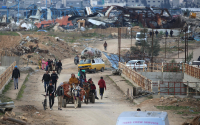Common Dreams / Published on Sunday, February 13, 2005 by Agence France Presse
Way back in 1968, US ecologist Garrett Hardin sketched the dilemma that today besets the Kyoto Protocol, the UN's global warming pact which takes effect on Wednesday.
In a landmark essay, "The Tragedy of the Commons," Hardin evoked the case of common land where everyone has the right to graze their cattle.
Even if the land becomes overgrazed, people will continue to put their animals on the damaged fields and even add to their herd, said Hardin.
The reasoning: Individuals see no point in making a sacrifice if others continue to use a common asset. Even if everyone is aware of the risk of abuse, the mix of selfishness, competitiveness and unregulated exploitation eventually makes the land unusable for all.
Swap the common land for Earth's atmosphere and overgrazing for greenhouse gases and you have the greatest environmental challenge of the early 21st century: how to tackle climate change.
The evidence for man-made global warming is now doubted only by a small minority of scientists.
The overwhelming view: Carbon emissions from burning oil, gas and coal are trapping the Sun's heat rather than let it radiate out to space -- a "greenhouse" effect with potentially far-reaching consequences for the delicate climate system.
The world's average temperature rose by 0.6 C (1.08 F) from 1900-1990 alone, and could increase by another 5.8 C (10.4 F) by 2100, depending on how much carbon dioxide (CO2) is in the air, according to the UN's Intergovernmental Panel on Climate Change (IPCC).
After the Nineties -- the hottest decade on record -- 2004 was the fourth warmest year, with the highest temperature rises recorded in Alaska, the Caspian Sea and the Antarctic peninsula, NASA scientists reported last week.
Experts admit there are some big knowledge gaps.
No one can say for sure exactly how bad the climate damage will be, if there are triggers that could worsen it (or alternatively, ease it) and what is a "safe" level of emissions.
But a conference staged in Exeter, England, this month by more than 100 climate scientists branded the danger as big and worsening, even if key details are lacking or open to debate.
The biggest expert gathering since the 2001 IPCC report said climate change was already affecting ecosystems and rainfall patterns and damaging polar ice and glaciers.
"In many cases, the risks are more serious than previously thought... (and) a number of new impacts were identified that are potentially disturbing," it said.
Among them, the risk of acidification of the sea, caused by the absorption of too much atmospheric carbon dioxide (CO2); the potential shutdown of the Gulf Stream, which provides western Europe with balmy weather; and early warnings of ice loss in Antarctica.
So much for the threat today and worries about what could lie down the road.
What about the solution? Well, the Kyoto Protocol is Hardin's dilemma personified.
Only a small number of countries are being asked to make real sacrifices for the global good. The other countries, in effect, get a free ride.
The pact commits industrialized countries to make targeted curbs in emissions of six greenhouse gases by 2008-2012. This carries a cost because their economies will have to improve fuel efficiency and convert to cleaner energy.
True, rich nations, which used carbon fuels to power the Industrial Revolution that generated their prosperity, are historically to blame for global warming.
But the deal does not include fast-growing populous countries like China, already the world's second biggest CO2 polluter, and India.
Nor does it include the United States, which is responsible for a third of all global CO2 emissions and says meeting its Kyoto targets would cost too much.
Even if Kyoto is enacted in full, industrialized signatories will at best reduce their emissions by a couple of percent over 1990: not even a dent on global emissions.
The International Energy Agency (IEA) estimates CO2 levels have already risen by 15 percent since 1990 and are set to rise by another 60 percent by 2030.
In contrast, the Exeter conference said that if the world wants to peg the temperature increase over pre-industrial times to 2.0 C (3.6 F) by 2100, pollution will have to peak in 2020 and then fall swiftly. Today's annual emissions of six gigatons would have to be roughly halved by 2095.
Climatologists are gloomy that this will ever happen, sensing only short-termism and a national focus for addressing a long-term, global problem.
Some hope for some technology breakthrough to wean the planet off fossil fuels or a climate shock that will focus minds. That way, the post-2012 Kyoto, for which negotiations begin late this year, could be inclusive, simple and enforce tough and universal emissions controls.
"I would be very surprised if the current growth rate of CO2 is not maintained for at least another two decades, no matter what policies are implemented," said Stephen Schneider, a professor at Stanford University in California.
"I'll be very pleased, looking back, wherever I am looking back from, if in 100 years we are able to keep it to under a doubling of CO2. That will be an effort."






